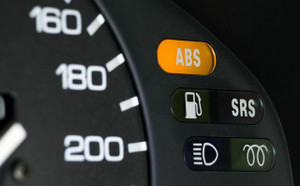How do anti-lock braking systems (ABS) work?
By Kijiji Autos
The anti-lock braking system (ABS) sits up there with seatbelts and airbags in terms of its widespread adoption in the automotive world. It's one of the most common and essential safety feature in cars.
But did you know ABS is actually quite old in car terms? We’re going to cover the brief history of this defining piece of tech, and how it keeps you safe on the road.
When and how did ABS become popular?
The modern ABS can trace its roots as far back as the early 20th century, with mechanical anti-skid systems for airplanes. ABS aimed to prevent the lock-up of the wheels during hard braking, which extends stopping distances and minimizes steering control.
The first electronic anti-skid system showed up on the Ford Thunderbird in 1969, but it only worked on the rear wheels. It would be two more years before the market saw a four-wheel ABS.
How does it work?
It was 1971’s Chrysler Imperial that offered the first four-corner ABS. Called Sure-Brake, it featured a speed sensor on each wheel and an electronic control box in the trunk. The system doesn’t pump the brakes as a driver would during hard stops: instead, it incrementally releases pressure as it detects lock-up.
This basic premise is how modern ABS work, too. It results in a noticeable pulsing feeling and sound from the brake pedal, which can surprise those unaware of the trait. That’s why it’s recommended to get to know your car’s braking capabilities in a safe environment when you first get it.
Modern ABS are interwoven into a car’s more advanced driver assist systems. In fact, starting in 2012 it technically became mandatory on all new cars sold in Canada. That’s because Transport Canada made electronic stability control (ESC) required on all light-duty vehicles, and ESC requires ABS to function.
Okay, so how does ABS help me?
ABS offers a few key advantages, especially in Canada. For one, it provides more consistent emergency stop distances, since the driver doesn’t have to worry about applying too much brake and locking the wheels. Remember that 1971 Chrysler Imperial? When Popular Science tested it at the time, it found the stopping distances were as much as 40% shorter on slippery surfaces.
There aren’t many countries that see slippery surfaces during more of the calendar than Canada. Winter can be full of nasty surprises on the road, including black ice. ABS can’t stop a slide from starting, but it allows a driver to focus on steering the car while the computer control unit handles the braking.
ABS is also central to another modern car feature: emergency brake assist. On cars so equipped, the computer can detect a potential accident and apply the brakes to avoid it. With ABS, the reaction time and maximum braking potential can be the difference between a crash and a safe stop.
Easily find your next ride on Kijiji Autos
Search nowHow Long Can a Car Sit Unused?
How long can a car be left without starting it? Keep reading to explore everything you need to know about unused cars.Costs of Installing an Electric Car (EV) Charging Station in Canada
Installing a home EV charger can come with additional fees beyond purchase and installation. Here's a list of factors that can affect the price of a home EV charger.Toronto to Calgary Road Trip: Routes & Tips
Planning on driving from Toronto to Calgary? Here are some routes and tips to help you along the way.Flat Tire vs Blowout: What's the Difference & What Should You Do?
The main difference between a flat tire and a blowout is that a blowout often feels like an explosion has occurred underneath your vehicle. Blowouts can cause sudden and drastic changes to the handling of your vehicle and can lead to minor or even serious accidents.7 items you can fit in an SUV: TVs, mattresses and more
Discover seven common items that fit in an SUV below.Tips to help protect your vehicle and budget for car repairs
When shopping for your next vehicle, it's always a good idea to keep hidden costs in mind. Before you buy, let's look at how much it can cost to maintain a car in Canada, how much you could budget for annual maintenance and repairs, and how to help protect your car against damage and depreciationThe top three best paint protection options for your vehicle
Buying a new vehicle is a great experience. Nothing beats hitting the road in a car you bought fresh off the lot. However, as fun as it is to finally get behind the wheel of your new ride, it's important to take your time through the process.What is the value of undercoat protection on your vehicle?
When you buy a new vehicle, protecting it so that it lasts as long as possible is definitely top of mind, whether that's through security upgrades or an extra coat of paint. But how often do you consider the care and safety of your vehicle’s undercarriage?Financial guide: post-pandemic car shopping and gas price hacks
With populations locked down and international borders closed the global supply chain has been disrupted on a massive scale, pushing up inflation around the world and raising the cost of everything that people need to get back to normal. Here are a few tips you can use to grab the vehicle you want without breaking the bank.10 tips to help make the road a better and happier place
We have all, at some point, been responsible for making the roadways stressful in one way or another. Alternatively, we are all equally capable of making the road a happier place. Let’s explore 10 unique ways we can help make the driving experience better again, for everyone's sake.








